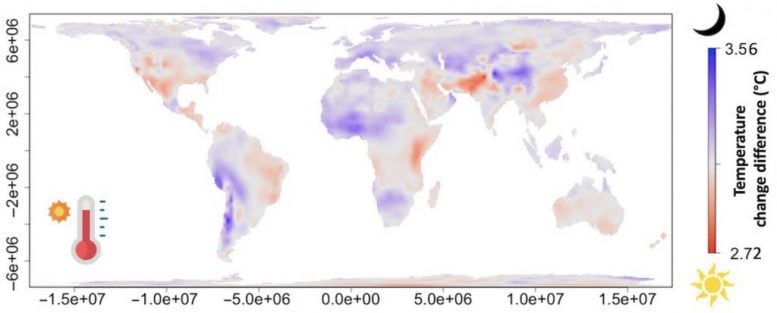
The global study examined hourly records of temperature, cloud cover, specific humidity, and precipitation. (One of the Expedition 40 crew members aboard the International Space Station photographed this nighttime image showing city lights in at least half a dozen southern states from some 225 miles above the home planet. Lights from areas in the Gulf Coast states of Texas, Louisiana, Mississippi and Alabama, as well as some of the states that border them on the north, are visible.) Credit: NASA
Global warming is affecting daytime and night-time temperatures differently – and greater night-time warming is more common than greater daytime warming worldwide – new research shows.
University of Exeter scientists studied warming from 1983 to 2017 and found a difference in mean annual temperature of more than 0.25°C between daytime and night-time warming in over half of the global land surface.
Days warmed more quickly in some locations, and nights did in others – but the total area of disproportionately greater night-time warming was more than twice as large.
The study shows this “warming asymmetry” has been driven primarily by changing levels of cloud cover.
Increased cloud cover cools the surface during the day and retains the warmth during the night, leading to greater night-time warming. Whereas, decreasing cloud cover allows more warmth to reach the surface during the day, but that warmth is lost at night.

Spatial variation in warming asymmetry across the diel cycle between 1983 and 2017. In total c.54% of the land surface has experienced warming asymmetry of >0.25°C, with more than twice the area of land warming more during the nighttime than the daytime. Driven primarily by changing levels of cloud cover this is associated with a wetting (increased nighttime warming) and drying (increased daytime warming) of the climate. The blue illustrates where the nighttime has warmed more rapidly, and red where the daytime has done so. The projection is Behrmann’s equal area. Credit: University of Exeter
“Warming asymmetry has potentially significant implications for the natural world,” said lead author Dr. Daniel Cox, of the Environment and Sustainability Institute on Exeter’s Penryn Campus in Cornwall.
“We demonstrate that greater night-time warming is associated with the climate becoming wetter, and this has been shown to have important consequences for plant growth and how species, such as insects and mammals, interact.
“Conversely, we also show that greater daytime warming is associated with drier conditions, combined with greater levels of overall warming, which increases species vulnerability to heat stress and dehydration.
“Species that are only active at night or during the day will be particularly affected.”
The global study examined hourly records of temperature, cloud cover, specific humidity, and precipitation.
The authors modeled the different rates of change of daytime maximum and night-time minimum temperatures, and mean daytime and mean night-time cloud cover, specific humidity, and precipitation.
They then looked at changes in vegetation growth and precipitation over the same period.
The study found that differences in daytime and night-time vegetation growth depended on rainfall.
Increased night-time warming led to less vegetation growth where it rained more, likely due to increased cloud cover blocking the sun. Whereas, vegetation growth was limited by water availability due to less rainfall where the days warmed more.
The research was funded in part by the Natural Environment Research Council.
Reference: “Global variation in diurnal asymmetry in temperature, cloud cover, specific humidity and precipitation and its association with leaf area index” by Daniel T. C. Cox, Ilya M. D. Maclean, Alexandra S. Gardner and Kevin J. Gaston, 30 September 2020, Global Change Biology.
DOI: 10.1111/gcb.15336
https://scitechdaily.com/weird-asymmetry-nights-warming-faster-than-days-across-much-of-the-planet/
2021-01-17 15:16:18Z
CBMiY2h0dHBzOi8vc2NpdGVjaGRhaWx5LmNvbS93ZWlyZC1hc3ltbWV0cnktbmlnaHRzLXdhcm1pbmctZmFzdGVyLXRoYW4tZGF5cy1hY3Jvc3MtbXVjaC1vZi10aGUtcGxhbmV0L9IBAA
Bagikan Berita Ini















0 Response to "Weird Asymmetry: Nights Warming Faster Than Days Across Much of the Planet - SciTechDaily"
Post a Comment